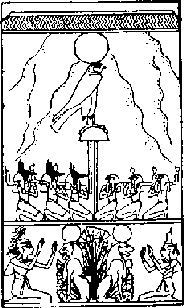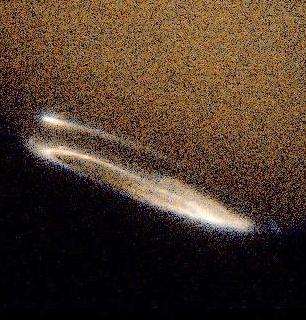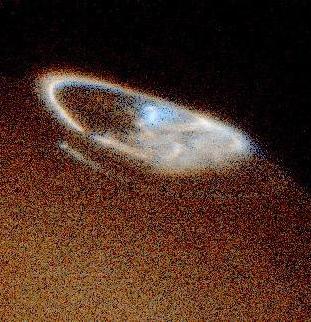Date: 9/11/00 4:10:52 PM Pacific
Daylight Time
From: cleland@nwlink.com (James Cleland)
To: BARDSQUILL@aol.com
On Dragons and Red Dwarves
9/11/00
Kent;
While we're on the subject of the possibility of Jupiter being a "failed"
star, let's not ignore the question of changes in (you guessed it) ORBIT:
"A long study of myth and iconography beginning from first principles rather
than standard interpretations, has led David Talbott and Ev Cochrane and
others to a model of the antique system in which Jupiter and Saturn are a
small binary system with Mars, Venus, and Earth orbiting this binary system
and the whole of the binary system orbiting the sun. At least, this is the
state in which the system finds itself at the time of the great mythical
systems.
Moreover, the larger of the two super-planets has the other super-planet
on one side, and the smaller planets on the other, producing a system in
which the bodies walk around the more major super-planet in unison in a system
of synchronous or synchronized orbits. This looks like a cane turning on
an axis, and produces the alignment which you saw in the image. In other
words, the planets remain stacked up overtop of each other as they turn around
the larger super-planet.
Further, the orbits are all fairly circular other than for that of Mars,
which is more pronouncedly egg-shaped.
To observers on the Earth, then, since the orbits are synchronous and Mars
remains overtop of the Earth, this MUST produce the visual effect of Mars
shrinking to a small size and then growing much larger on a regular basis.
Surely references to that could not be lacking in mythologies and early
literature.
Ev Cochrane has produced an intriguing study titled "On Dragons and Red Dwarves"
in the February 95 issue of Aeon. What he has discovered, is that Mars is
referred to not so much as a god, but as a "warrior/hero" in the most ancient
mythologies of numerous nations, and that the theme of this warrior/hero
regularly changing from a dwarf to a giant and back again is, as the model
predicts, archetypal.
Highlights include:

"A giant tree is also the eclipsing agent
in a fascinating tale preserved in the Kalevala.
"There the hero who eventually frees the
sun, strangely enough, is a homunculus by the
name of Sampsa. The Finnish account reads as follows:
'A man rose out of the sea, a hero from
the waves. He was not the hugest of the huge
nor yet the smallest of the small: he
was as big as a man's thumb Confronted with
this strange little man, a wiseman [Vainamoinen]
chides him with the following words:
"You seem more like a man to me and the
most contemptible of heroes. You're no
better than a dead man and a face on you like
a corpse!"19
At this point the little man blurts back:
"I am a man as you see-small, but a mighty
water-hero. I have come to fell the
oak-tree and splinter it to fragments!"
Vainamoinen, old and wily, scoffed: "Why,
you haven't the strength, you'll never
be able to fell the magic oak-tree and splinter it
to fragments!"
Scarcely had he said these words when,
before his eyes, the little man was transformed
into a giant. He stamped with his feet
on the earth and his head reached up to the
clouds; his beard flowed to his knees
and his hair to his heels. His eyes were fathoms
wide and his legs fathoms long. .. He
struck the tree with his axe... Sparks flew from the
axe and flame from the oak as he tried
to bend the magic tree to his will. At the third
stroke the oak-tree was shattered...
Now that the oak-tree was felled and the proud
trunk levelled, the sun shone again...
The sudden growth of Sampsa offers an
intriguing parallel to the rapid swelling which
forms such a prominent motive in the
traditions surrounding Indra and Cuchulainn.20 It
is a motive that we will encounter again
and again in the traditions surrounding the
warrior-hero.
...The Maya hero Ez, for example, is said to
have assumed a tiny form in order to
gain entrance into the belly of a great dragon.
Shortly thereafter, "When the serpent
swallowed him, he cut his way out with the obsidian
and killed the serpent. He emerged bigger
and stronger than before. "42
As a dragon-slaying dwarf, Ez has numerous
parallels in the sacred traditions of Pre-
Columbian Indians from North and South
America. Consider, for example, a fascinating
figure from South America known as Mura,
the trusty servant of the great god Pura, the
primal sun.43 Described as a red dwarf
renowned for his club and giant knife, Mura is
said to reside upon the World Mountain
at the center of heaven, together with-but in a
position subordinate to-the sun-like
Pura. Once upon a time, according to Arikena
tradition, Pura and Mura found themselves
in the belly of a great serpent and it was only
with great difficulty that they eventually
hacked their way out thanks to the
aforementioned knife.44 It is the possibility
of relating Mura to the red planet that peaks
our attention, of course, and thus it
is tempting to compare the club-bearing red dwarf
with Heracles, the latter alike being
renowned for his club and homunculus-like (daktyl)
form.45
As is the case with any truly archetypal
mythical motive, the shape-shifting red dwarf
can be found throughout the ancient world.
46 A prominent example can be found in the
Ramayana, where a trickster-like figure
by the name of Hanuman finds himself
confronted by a giant monster:
Later, a huge form stood in his way and
said: "Enter my mouth. I have been without
food for a long time and am eagerly waiting
for you," and the monster opened wide
like a cave... Hanuman thought quickly
and decided what to do. Step by step he
made his body grow bigger and bigger.
The Raakshasa form (the monstrous form
assumed by Surasa, a Naaga goddess) opened
its mouth correspondingly wider and
wider. When the mouth was thus enormously
wide, all of a sudden Hanuman
contracted his body into a speck and,
darting through the demon's mouth and body,
came out again and resumed his former normal shape.47
Hanuman resorts to the same ploy on another
occasion. This time, however, it is the
very fact of the hero's assuming a gargantuan
form that causes the belly of the dragon to
burst, thereby bringing about its death.
Jung summarizes the episode as follows: "Once
more he had recourse to his earlier stratagem,
made himself small, and slipped into her
body; but scarcely was he inside than
he swelled up to gigantic size, burst her, and killed
her, and so made his escape."48
The fact that Hanuman (or his face) is
elsewhere said to be ruby-red in color offers a
striking parallel to the aforementioned
dwarves from the New World.49 Nor can the
shape-shifting contortions ascribed to
Hanuman fail to evoke comparison with the
grotesque contortions undergone by the
ruddy-colored heroes Cuchulainn and Indra
whilst in the throes of their respective "
furors".50 In Indra's case, it will be remembered,
he swelled to such an extent that he
dominated the region between heaven and earth,
actually threatening to block out the
light of the sun. Recall again the Vedic description
of Indra' s epiphany:
Indra, endowed with all heroic valor.
Then up he sprang himself, assumed his vesture,
and filled, as soon as born, the earth
and heaven.51
A similar passage is the following: "
Indra, Impetuous One, hath waxed immensely: he
with his vastness hath filled earth and heaven."52
Indra's ability to assume a gigantic
form is a decided point of emphasis in the Vedic
hymns, and more than one scholar has
called attention to the prominent role of the root
vrdh, "to increase, or swell," in his
mythus.53 A stock epithet of the god-Pravrddha-
emphasizes this ability to swell, signifying "
swollen, enlarged, expanded, increased,
violent. "54
AEON is a journal of science devoted to the collection and exploration of
archaeo-astronomical traditions and analysis of common patterns in ancient
myths from around the world. Articles and abstracts build upon the pioneering
work of Immanuel Velikovsky, author of the best selling "Worlds In Collision".
Featured topics include:
a.. Evidence of catastrophic planetary interactions in historic times
b.. Reconstruction of standard archaeological dating systems
c.. Evidence for cataclysmic evolution and extinction
d.. Astral worship in the Egyptian Pyramid Texts, the Veda, and ancient Babylon
and mythological traditions surrounding the planets in general
e.. Astral myths of the American Indians, astral worship in Meso-America
f.. The role of Osiris in Egyptian myth; Thor; the Mother goddess; the birth
of Athena; Oedipus in Comparative Mythology; etc.
g.. Common elements in the myths of Heracles, Indra, and Cuchulainn; in the
myths of Heracles and Gilgamesh and myths of the Deluge from around the world
Please send all manuscripts and inquiries to:
AEON
601 Hayward,
Ames, IA, 50014.
email: ev.cochrane@ames.net
Subscriptions are $40 per year* $55 foreign air mail." >>
-----------------------------------------------------
Subj: How the Stuff
Gets Here
Date: 9/11/00 7:18:58 PM Pacific Daylight Time
From: cleland@nwlink.com (James Cleland)
To: BARDSQUILL@aol.com
Observations of solar wind plasma entry into the magnetosphere
The observations of one of the two Russian Interball satellites have revealed
new information on solar wind plasma entry into the magnetosphere. The
observations took place in January 1997 when a huge solar plasma cloud
originating from a coronal mass ejection passed the Earth's magnetosphere.
After the passage the collaborative Swedish-Finnish-Russian plasma instrument
observed, for an exceptionally long time, impulsive plasma entry into the
magnetosphere in a local sector where such entry has not been reported
previously. These observations are expected to have a significant impact
on understanding solar plasma entry into the magnetosphere.
I. Sandahl, H. E. J. Koskinen, A. M. Mälkki, T. I. Pulkkinen, E. Yu.
Budnik, A. Fedorov, A. L. Frank, J. B. Sigwarth, Dispersive magnetosheath-like
ion injections in the evening sector on January 11, 1997, Geophys. Res. Lett.,
in press 1997
----------------------------------------------------
9/11/00 Although I don't particularly agree
with the idea of combining scientific research with philosophical or religious
speculation, I think that the Millennium Group
http://www.millenngroup.com/repository/solar/orca2.html
might be on-target with their idea that events like "Weird One" are visible
"magnetic flux tubes", like this one:
Astronomy Picture of the Day
January 23, 1998
Jovian Aurora
Credit: J. Clarke (Univ. Michigan),
NASA
Explanation: These two recently
released Hubble Space
Telescope close-ups show the
Northern and Southern
lights ... on
Jupiter. Like
aurora on Earth, these Jovian
aurora are
caused by charged particles funneled into the atmosphere above the planet's
North (right) and South poles by
magnetic
fields. But Jupiter's magnetic field is extremely large and ionized material
expelled from the
volcanic moon Io is trapped in it creating light shows 1,000 times more
intense than Earth's
auroral storms. Charged particles released by Io are also
funneled along magnetic flux tubes which form a direct "bridge"
to the Jovian atmosphere. The result is auroral hot spots - magnetic
footprints 600 or more miles across which race over
Jupiter's cloud
tops. A hot spot is visible in both images as a comet-like feature just
outside the polar
auroral rings. In these false color ultraviolet images, Jupiter's limb
(edge) appears dull brown while
the auroral
displays are shades of white and blue.
This leads to some interesting concepts:
Picture a planet such as ours circling a small star such as Jupiter or
Saturn, or possibly a small double star composed of two such, the pole of
the planet pointed straight at the small star. This means daylight on one
side, darkness on the other. Always... you just don't live on the dark side.
This means, no seasons. You just pick what kind of weather you like, and
you live at that latitude.
Picture a tube of electromagnetic flux between the small star and the
planet (as may be seen now between Jupiter and Io). Primitive people living
on the planet, having no knowledge of physics or electromagnetic flux tubes,
would simply believe that the great god, the small star, lived atop the magic
mountain, and so draw it on the walls of their pyramids, said pyramids themselves
being representations of said magic mountain, or flux tube. From:
http://www.bearfabrique.org/Saturn/saturnmyth.html
This, of course, is just interesting speculation (or is it?). The
point is, these tube-like Solar emanations are too symmetrical to be CME's
or flares. And, if they are not "artifacts", that means that they are
almost certainly magnetic, electromagnetic, or plasma, tubes. And,
if they are, science tells us that these tubes CONNECT things. I have
learned in a few minutes of searching the net under "magnetic flux tubes",
that these tubes can, most certainly, BEND (not too bad for a kid who got
a "D" in high-school algebra, huh?). Now, once again, if these tube-like
events are not "artifacts", this means that plasma physicists are
paying attention to them, communicating with each other in jargon, and NOT
TELLING US. Doesn't seem fair, does it?
Is there a plasma physicist in the audience?
Jim
Date: 9/11/00 7:46:02 PM Pacific Daylight Time
From: cleland@nwlink.com (James Cleland)
To: BARDSQUILL@aol.com
"Known natural plasma wave phenomena... include MHD velocity turbulence
associated with magnetospheric plasma convection, magnetic pulsations,
electrostatic and electromagnetic ion cyclotron waves, lion roars in the
magnetosheath and cusp, magnetic noise bursts and turbulence along auroral
field lines, chorus and hiss, whistlers, electrostatic cyclotron harmonics,
continuum radiation, and kilometric radiation. These wave phenomena are closely
associated with the transport and acceleration of plasma in the earth's
magnetosphere."
Well..any fool knows that. ("lion roars in the magnetosheath"?)


